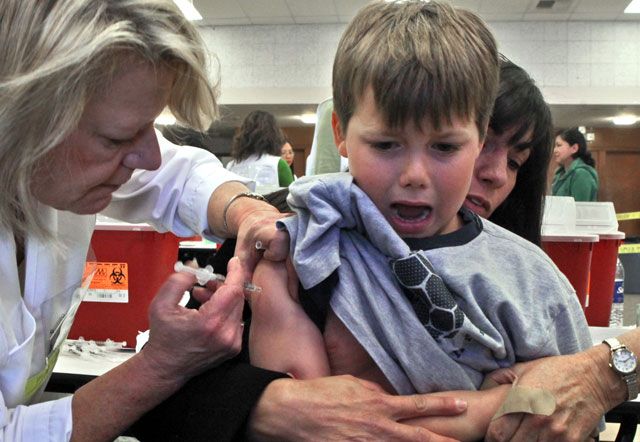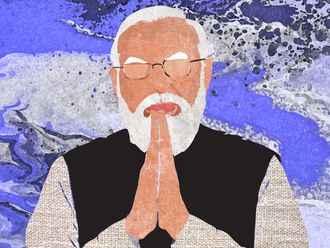When swine flu erupted this spring in the southwestern United States and Mexico, it had been 40 years since the last flu pandemic. The outbreak has dispelled any illusion that pandemic influenza belonged to a bygone era, like smallpox, polio or scarlet fever. But we haven't seen how bad things might yet get.
What's the worst-case scenario? It could be a continuing vaccine shortage. It might be a mutation in the swine flu virus that suddenly makes the strain resistant to Tamiflu, as some seasonal flu strains already are. Or it could be that hospital ICUs become so overwhelmed that people who could have been saved die.
These are all unnerving possibilities. Yet many flu specialists say their real nightmare is that swine flu could meet up and swap genetic material or reassort, as these scientists say with another, deadlier flu strain, breeding a new virus that is as contagious as but far more savage.
Deadly
Such a strain is already circulating in Asia and Africa, and it could be ready for a chance encounter with swine flu. It is called bird flu. Unlike swine flu, which is no worse than a seasonal flu bug for most people, bird flu kills more than half of those who contract it: Of 460 confirmed human cases of bird flu, 268 of those people died. Bird flu preys on the young and healthy, ravaging their lungs reminiscent of the 1918 flu that killed up to 50 million people.
So far, scientists haven't found proof that swine and bird flu will merge and spawn a deadlier virus. But the prospect is so chilling that health officials have been warning about it since earlier this year. Margaret Chan, director general of the World Health Organisation, urged public health experts not to take their eyes off H5N1 bird flu even as H1N1 swine flu was sweeping the globe this spring.
"No one can say how this avian virus will behave when pressured by large numbers of people infected with the new H1N1 virus," she told an assembly of the world's top health officials in May.
Influenza is a cruel wonder of nature, one of the most promiscuous microbes. Its viruses have a rare gift for swapping genetic material with one another: The genetic material in a flu virus, unlike in nearly all other viruses, is composed of segments that can be individually replaced. If two different strains invade the same cell, they can trade attributes, then dispatch that progeny back into the world. So the WHO and other health agencies are watching closely as swine flu spreads to countries where bird flu is well established, particularly Egypt and Vietnam.
As a correspondent, I tracked bird flu for several years starting in 2004 in nine Asian countries, from jungle villages to squalid urban quarters, run-down hospitals and cutting-edge labs. I discovered how economic, political and cultural realities were conspiring to imperil us. In a single generation, East Asia's surging demand for protein has led to an explosion in poultry farming, and these flocks have become perfect breeding grounds for a pandemic strain. Meanwhile, age-old customs facilitated the virus' spread.
And now, along comes swine flu. Although its mortality rate is well below one per cent, there have already been tens of millions of cases worldwide. Is this more-contagious virus the key that might unlock bird flu's terrible full potential? Swine flu is so new that researchers have yet to plumb its secrets. How exactly is it transmitted, how does it attack the body, and why, in very few cases, is it catastrophic? Could it reassort with another flu strain?
Last summer, scientists from the University of Maryland, the Virginia-Maryland Regional College of Veterinary Medicine and the National University of Colombia published the results of their swine flu research on ferrets. (Ferrets are susceptible to human flu viruses and display some of the same symptoms as people.) The study suggested that swine flu is unlikely to reassort with ordinary seasonal strains and instead is more apt to crowd them out. We can only hope that it will be equally chaste when it comes to bird flu.
New flu strains
But another study, also published this summer, showed that bird flu has the ability to reassort with at least some other strains of flu. A team at the Centres for Disease Control and Prevention in Atlanta confirmed this by infecting ferrets with bird flu and ordinary seasonal flu simultaneously. Testing secretions from the ferrets' noses, researchers found that they carried new flu strains that contained genetic material from both of the parent strains.
We cannot predict the twists and turns of the flu virus, which has repeatedly confounded some of the world's brightest scientists. No one expected bird flu would leap from birds to humans until it did.
Already, the swine flu epidemic has chastened us by revealing the sorry state of our antiquated technology for producing vaccines and the limits of our brittle, underfunded system for emergency medical care. But swine flu is not merely a warning shot. The virus itself could be the catalyst for a new flu — and an even deadlier pandemic.
Alan Sipress, The Washington Post's economics editor, is the author of The Fatal Strain: On the Trail of Avian Flu and the Coming Pandemic.












